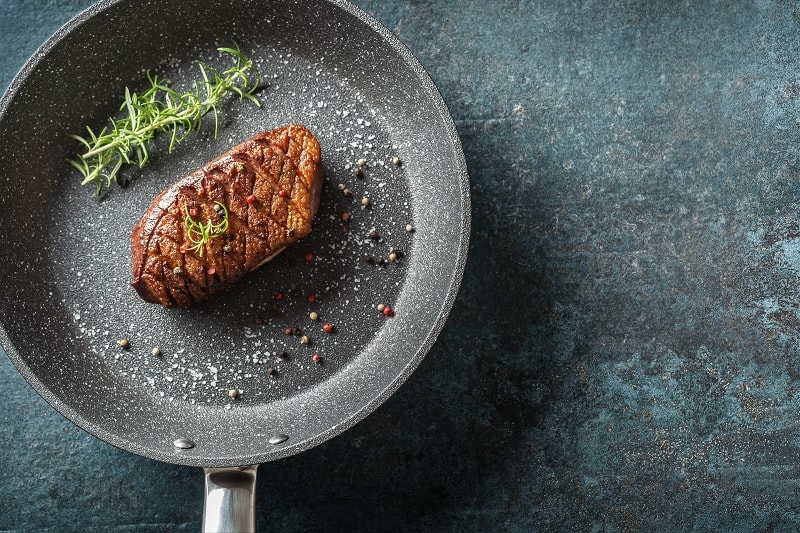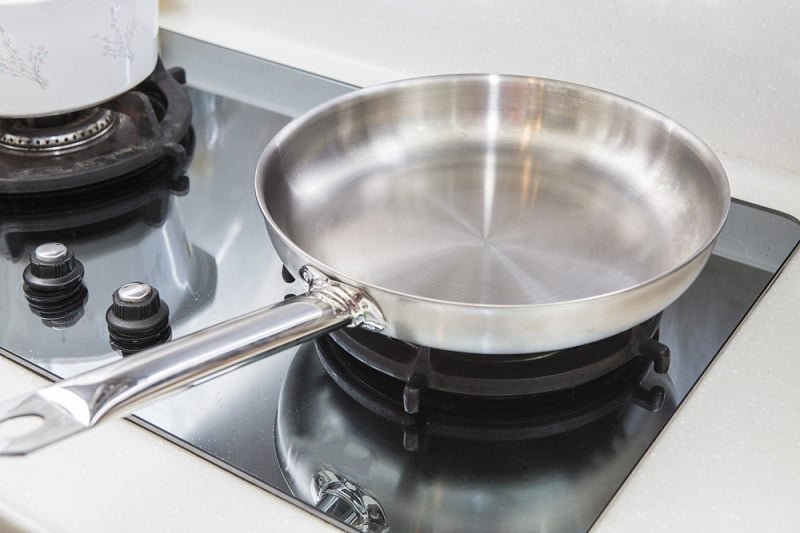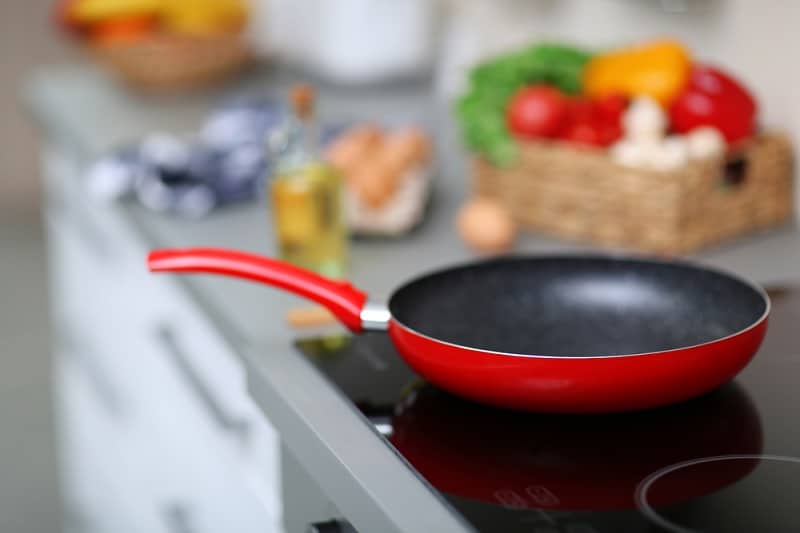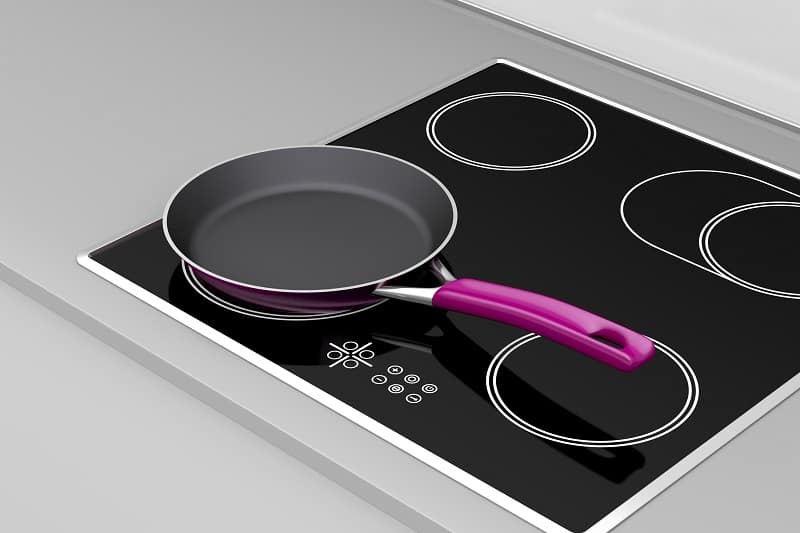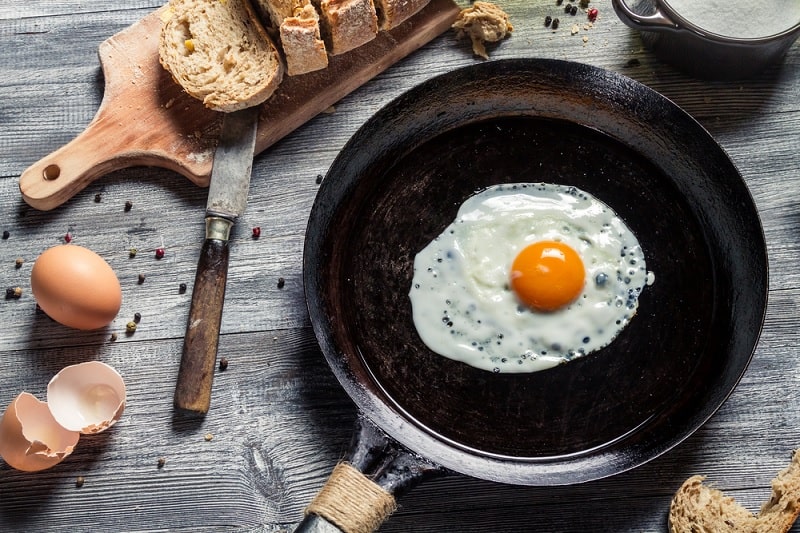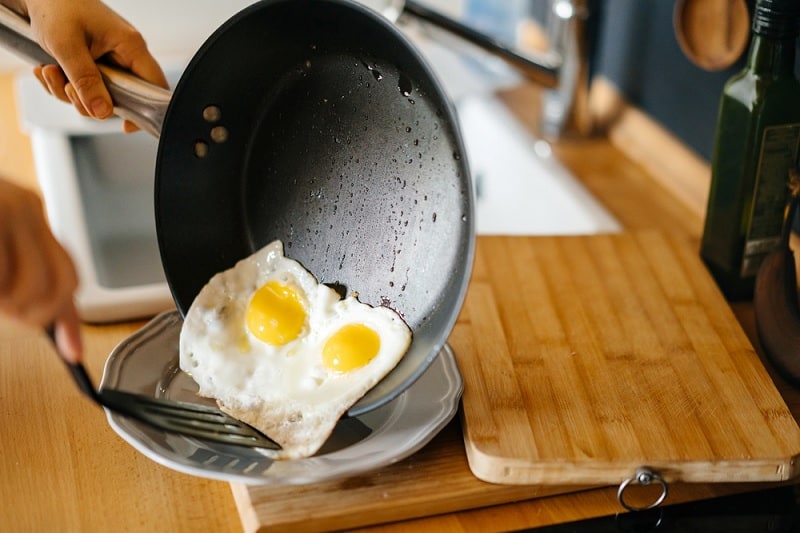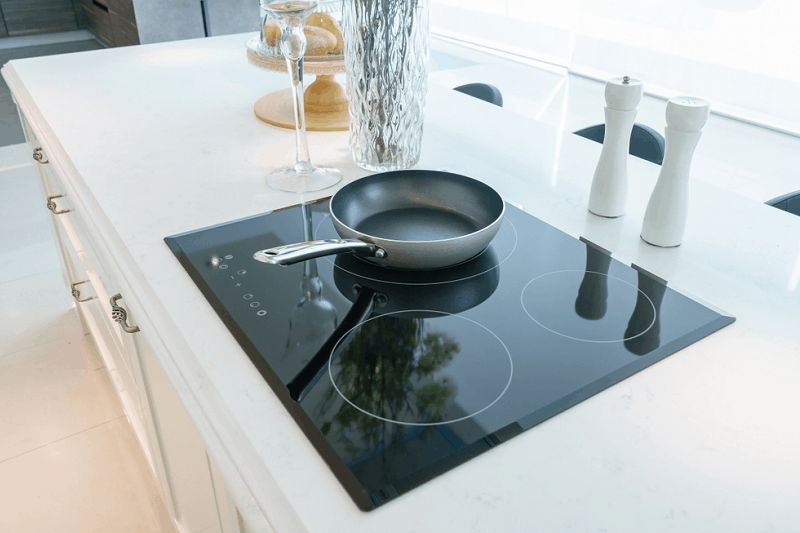Ceramic frying pans are a popular choice thanks to their non-stick properties, which make them easy to use and easy to clean.
A good ceramic pan is considered an essential tool in the kitchen by many. But which is the best to buy right now in the UK?
We’ll explore some of the most popular and highly rated options below, and give you some pointers on how to choose the perfect pan for your kitchen.
Best Ceramic Frying Pans in the UK
1. MasterClass Eco Frying Pan

Diameter: 20 cm (8 inches)
Material: Aluminium, iron
This frying pan from MasterClass has a chemical-free ceramic non-stick coating. It is made from excellent quality aluminium, and it has a flat iron base meaning it can work with induction hobs.
The frying pan we have here is 20 cm, but MasterClass also makes this model in a few other sizes.
The reason this frying pan made our list is that it is exactly what a ceramic frying pan should be. This pan is very well made, the non-stick coating is exceptional, and it looks great too.
If you’re looking for a frying pan that will last years and doesn’t cost the earth, this is a great option!
This frying pan is perfect for any chef but in particular beginners. They can take advantage of the superior non-stick properties and learn to good excellent food.
2. INTIGNIS Frying Pan With Lid

Diameter: 28 cm (11 inches)
Material: Aluminium
INTIGNIS call this pan the “queen of the kitchen”, and as it is a 3-in-1 induction frying pan, we can really see why. This pan can be used for three functions: as a mini wok, a saute pan or a deep frying pan.
This 28 cm frying pan comes with a lid. The size and the lid make this pan extremely versatile. Whether you want to fry steak or make a sauce for your steak, you can do it all in this pan.
The German GREBLON ceramic coating makes cooking with this pan really easy as well. Nothing will stick to the bottom of this pan. You can use it to sear salmon to perfection or cook your favourite omelette, and cleaning up will be super easy.
The pan also has two pouring spouts, so if you are using it to make a sauce, you won’t drop it all over the counter when serving.
This pan is super durable and incredibly handy, perfect for a beginner cook who wants a pan that can do it all, but also great for seasoned chefs who need versatility in the kitchen.
3. Home Icon Non-Stick 26cm Copper Frying Pan
Diameter: 26 cm (10 inches)
Material: Copper
This copper frying pan has a unique triple layer of non-stick coating, making it one of the best non-stick ceramic frying pans on the market.
It measures 26 cm across, offering plenty of space for steaks, fish, or a large omelette for the whole family.
This pan is made from aluminium too, so it is nice and light. The handle is also metal which means it can go in the oven. And thanks to the extremely hard-wearing non-stick coating, this pan can be used in the oven up to 260 degrees Celsius.
Home Icon is so confident about these pans that they provide a three-year warranty with them. They are oven-safe, induction hob compatible and have a chemical-free non-stick coating that is basically unbeatable.
4. Blue Diamond Ceramic Non-Stick Frying Pan

Diameter: 24 cm (9.5 inches)
Material: Aluminium
This Blue Diamond non-stick pan comes in a variety of sizes. We have chosen the 24 cm pan here, but you can grab the same pan in 20, 28, 30 and 32 cm.
The ceramic coating on this pan is extremely durable. It is 10 times more durable than a typical non-stick coating. So, treat this pan well, and you’ll own it for years.
The base construction of this pan is aluminium, and it is induction hob safe. You can use this frying pan in the oven to 220 degrees as well.
You can even pop this frying pan in the dishwasher, although Blue Diamond does suggest hand washing it to keep it in good condition. The non-stick coating is so good, though, that hand washing this pan will take seconds!
5. GreenChef Profile Plus Stainless Steel Frying Pan 20cm

Diameter: 20 cm (8 inches)
Material: Stainless steel
The ceramic coating on this pan is reinforced by diamonds. The body of this pan is made from stainless steel, and it has an extra-thick base.
This aids in heat retention and means that the pan is suitable for all hob types. It is also dishwasher and oven safe.
What makes this pan special, though, is the non-stick coating. Right now, the non-stick coating on this pan is the best on the market.
What Makes Ceramic Frying Pans Healthy?
Manufacturers of ceramic cookware claim that it is a healthy option, but why? Does the ceramic release something into your food that makes it healthier? Well, no, actually it is the opposite.
You see, traditional non-stick coatings on frying pans and pots, contain harsh chemicals. These chemicals (PFOA, PTFE and more) can release toxins when you’re cooking.
Granted, it takes a lot of heat for these toxins to be released, and it isn’t a regular occurrence in typical cooking tasks. Still, it’s nice there is a non-stick option for those of us that don’t want to take the risk.
So, one health benefit to ceramic frying pans is there are no harsh chemicals used in the non-stick coating.
The other health benefit of ceramic coatings comes from how well they perform their job. Ceramic non-stick coatings are so good that you need far less oil or butter when cooking. The reduction in fats is great for any diet.
So, while ceramic frying pans may not have any direct health benefits, they help reduce the number of chemicals in your home and reduce the amount of fat in your diet.
So, how do you choose the right ceramic frying pan for your needs? Well, that’s what we’re looking at next.

Choosing the Right Ceramic Frying Pan for Your Needs
Size
When choosing a frying pan, there are a few things to think about. Firstly, size. Ceramic frying pans come in a few different sizes.
We recommend owning a couple of frying pans of different sizes, it can make cooking separate components of meals a lot easier.
We’d go with 20cm, 26cm and 30cm frying pans. These sizes will keep you covered for pretty much every cooking task.
Material & induction compatibility
Most of the ceramic frying pans in this article are made from aluminium which is a fantastic choice for a frying pan as it heats up quickly and holds the heat really well.
However, some of the pans featured here will not work on an induction hob. If you have an induction hob, make sure that the frying pan (or at least the base) is compatible. Don’t worry, we’ve mentioned which frying pans are induction hob compatible.
Wall thickness
Some frying pans have thicker walls than others. Now, this doesn’t mean that the thinner frying pans are poor quality, they are just designed for a different type of cooking.
Thinner walled frying pans are designed to heat up really quickly and are perfect for flash frying. Thicker walled pans are designed to hold heat in a lot better.
Both types of frying pan will work for most general cooking tasks, this is more about personal preference.
Metal or plastic handle?
With a metal handle, you can transfer your frying pan to the oven. You can with some plastic handled pans too, but not all.
If you like to flash fry and then transfer to the oven, a metal handle is probably better for you. If you aren’t too worried, plastic will be fine.
That is about it. Ceramic frying pans are fantastic and provide superior cooking for many years. And considering all of the things above will mean your new frying pan will be enjoyable to use too.
But which pan will you choose? Well, here are some of our favourite ceramic frying pans in the UK right now.
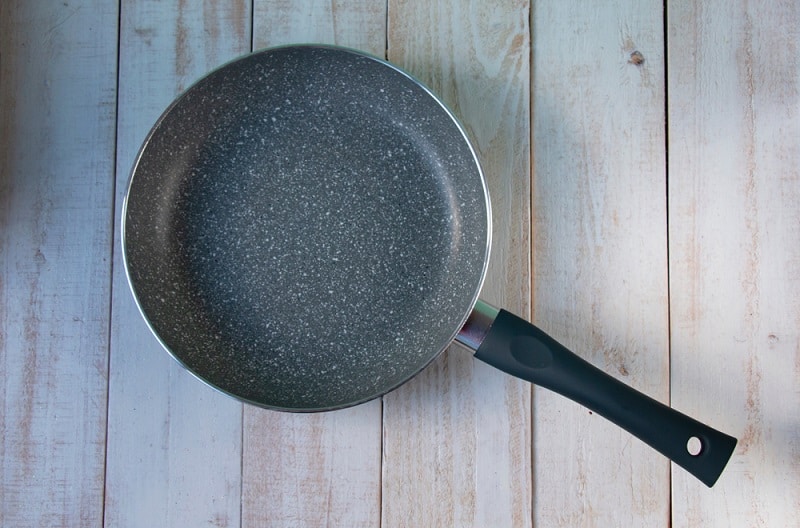
Conclusion
So, that is our list of ceramic frying pans. We hope you’ve found the ceramic frying pan of your dreams on this list.
If it were us, we’d happily use the MasterClass Eco Frying Pan every day of the week.
Don’t forget to check out our other cookware articles. We have all the articles you need on here to kit out your kitchen and cook fantastic meals!

Scott is a writer and a passionate home chef. His passion for cooking began when he was 10 years old. Scott has been writing professionally for over five years now and loves to combine his passion for cooking with his day job.

